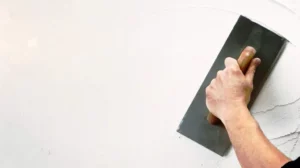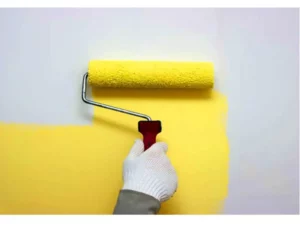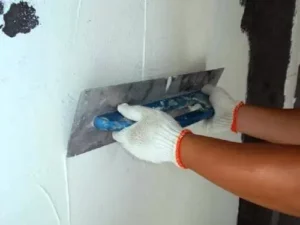One of the most common design mistakes we see is with scale and proportion. This element of design applies to all aspects of a project, whether it is with scale and proportion of wallscape, furnishings, or even accessories. Most people are afraid of going too big, but the old adage of ‘bigger is better’ sometimes does apply. Don’t be afraid to be bold! To start with– your wall is your canvas.
Steer clear of plain white walls, unless the architecture demands it. 90% of the time white walls make everything against the wall visually float. Use a mid-tone wall color or neutral hues that unify all of the pieces. The only times’ white works are if it is a conscious design decision with a limited palette, utilizing lots of texture or contrast.
Wall putty is used before painting on the wall or other surfaces. It is a far better option compared to the traditional plaster of Paris. It is made from ultrafine powder and has moisture-absorbent qualities. The major ingredients are white cement, polymers, and fillers for making it smooth nullifying the need for further curing. Different brands of wall putty are available in the market and anyone of the leading brands can be used before painting. Some brands have two grades of putty, waterproof grade, and normal grade. The normal wall putty is the first coat applied on the walls to cover the major coarse patches or undulations. The second coat of wall putty is then applied to get smooth topcoat paint (finish coat) on the walls.
The number of coating of the wall putty will depend on the condition of the wall or surface. A given surface with large undulations and patches may need more coating then relatively plain or smooth surfaces. Before applying wall putty, the surface should be made free from oil, dust or any particles. In order to cure major patches or fault lines, cement paste must be applied to cover those patches and after covering major undulations and irregularities on the surface, wall putty can be applied with a spatula. The surface or wall should ideally be made wet in order to provide a strong bond. The coating of primer is not required after using wall putty, nor does it require curing.
Wall putty is ideal for decorating exterior and interior walls of houses or buildings. The wall putty can be used on old painted walls as well. But the existing paints should be scrubbed and removed before applying the wall putty. It can be used on walls in homes, offices, residential buildings, malls, showrooms, stadiums, exhibition halls or on any surface before painting.
When wall putty is applied on the wall, it becomes an integral part of the plaster. The water resistance property of the wall putty ensures that paint is not coming off when walls are damp. This gives a long life to the paints. The final smooth surface gives stunning results when the paint is applied to it. It also brings out true color of the applied paint because of the white cement base in the wall putty. It also reduces the consumption of paint by up to 25 %.
Wallscape tips
Never apply paint samples to a wall and always order full-size swatches to move easily throughout the room at different times of the day. Use two samples in corners to show the intensity of color reflected off itself – four painted walls can look much different than one.
The installation of artwork is critical. Don’t take the short cut approach, with one piece hung on every wall space at about the same height. Don’t hang your artwork too high—floating on its own. And don’t forget to leave some space for your eye to rest. Every wall surface does not have to be covered. Consider the entire composition of the room.
Purpose of applying Wall Putty: There are several reasons for which we apply Putty on walls.
- Putty is used to filling up the fine cracks and to make a smooth and even surface for painting.
- It is applied to prevent access of moisture into walls as it is water-resistant.
- Putty can also be applied on moist surfaces.
- It protects the wall by preventing the growth of fungi and algae on it.
- It doesn’t need to be cured after application.
- Putty improves the appearance, stability, life span and durability of paints.
- It reduces the consumption of paint and hence makes painting work economical
- It improves the tensile strength of the wall.
TIGONIS Wall putty –The essence of ultrafine decor
Tigonis Wall putty is a white cement-based powder finished coating applied on walls, surfaces, and ceilings. This covers unevenness, undulations and pinholes on the plastered surface. It strengthens the wall and protects expensive paints from dampness, efflorescence, and moisture. Tigonis Wall Putty is modified with polymers and special additives for enhanced strength, finish, and performance. Tigonis delivers the real essence of ultrafine decor—always.



